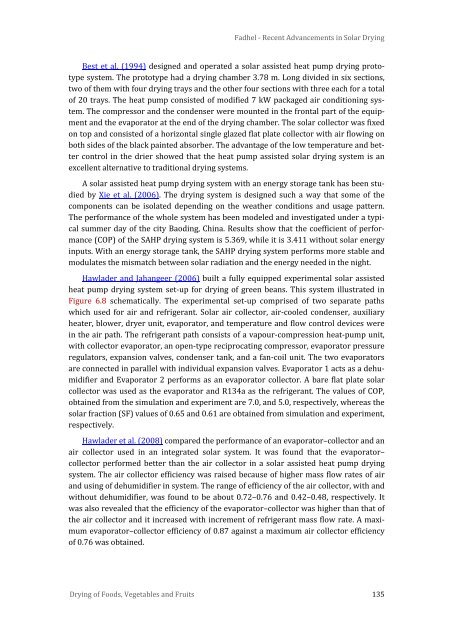Solar Drying: Fundamentals,Applications and Innovations - National ...
Solar Drying: Fundamentals,Applications and Innovations - National ...
Solar Drying: Fundamentals,Applications and Innovations - National ...
You also want an ePaper? Increase the reach of your titles
YUMPU automatically turns print PDFs into web optimized ePapers that Google loves.
Fadhel - Recent Advancements in <strong>Solar</strong> <strong>Drying</strong><br />
Best et al. (1994) designed <strong>and</strong> operated a solar assisted heat pump drying prototype<br />
system. The prototype had a drying chamber 3.78 m. Long divided in six sections,<br />
two of them with four drying trays <strong>and</strong> the other four sections with three each for a total<br />
of 20 trays. The heat pump consisted of modified 7 kW packaged air conditioning system.<br />
The compressor <strong>and</strong> the condenser were mounted in the frontal part of the equipment<br />
<strong>and</strong> the evaporator at the end of the drying chamber. The solar collector was fixed<br />
on top <strong>and</strong> consisted of a horizontal single glazed flat plate collector with air flowing on<br />
both sides of the black painted absorber. The advantage of the low temperature <strong>and</strong> better<br />
control in the drier showed that the heat pump assisted solar drying system is an<br />
excellent alternative to traditional drying systems.<br />
A solar assisted heat pump drying system with an energy storage tank has been studied<br />
by Xie et al. (2006). The drying system is designed such a way that some of the<br />
components can be isolated depending on the weather conditions <strong>and</strong> usage pattern.<br />
The performance of the whole system has been modeled <strong>and</strong> investigated under a typical<br />
summer day of the city Baoding, China. Results show that the coefficient of performance<br />
(COP) of the SAHP drying system is 5.369, while it is 3.411 without solar energy<br />
inputs. With an energy storage tank, the SAHP drying system performs more stable <strong>and</strong><br />
modulates the mismatch between solar radiation <strong>and</strong> the energy needed in the night.<br />
Hawlader <strong>and</strong> Jahangeer (2006) built a fully equipped experimental solar assisted<br />
heat pump drying system set-up for drying of green beans. This system illustrated in<br />
Figure 6.8 schematically. The experimental set-up comprised of two separate paths<br />
which used for air <strong>and</strong> refrigerant. <strong>Solar</strong> air collector, air-cooled condenser, auxiliary<br />
heater, blower, dryer unit, evaporator, <strong>and</strong> temperature <strong>and</strong> flow control devices were<br />
in the air path. The refrigerant path consists of a vapour-compression heat-pump unit,<br />
with collector evaporator, an open-type reciprocating compressor, evaporator pressure<br />
regulators, expansion valves, condenser tank, <strong>and</strong> a fan-coil unit. The two evaporators<br />
are connected in parallel with individual expansion valves. Evaporator 1 acts as a dehumidifier<br />
<strong>and</strong> Evaporator 2 performs as an evaporator collector. A bare flat plate solar<br />
collector was used as the evaporator <strong>and</strong> R134a as the refrigerant. The values of COP,<br />
obtained from the simulation <strong>and</strong> experiment are 7.0, <strong>and</strong> 5.0, respectively, whereas the<br />
solar fraction (SF) values of 0.65 <strong>and</strong> 0.61 are obtained from simulation <strong>and</strong> experiment,<br />
respectively.<br />
Hawlader et al. (2008) compared the performance of an evaporator–collector <strong>and</strong> an<br />
air collector used in an integrated solar system. It was found that the evaporator–<br />
collector performed better than the air collector in a solar assisted heat pump drying<br />
system. The air collector efficiency was raised because of higher mass flow rates of air<br />
<strong>and</strong> using of dehumidifier in system. The range of efficiency of the air collector, with <strong>and</strong><br />
without dehumidifier, was found to be about 0.72–0.76 <strong>and</strong> 0.42–0.48, respectively. It<br />
was also revealed that the efficiency of the evaporator–collector was higher than that of<br />
the air collector <strong>and</strong> it increased with increment of refrigerant mass flow rate. A maximum<br />
evaporator–collector efficiency of 0.87 against a maximum air collector efficiency<br />
of 0.76 was obtained.<br />
<strong>Drying</strong> of Foods, Vegetables <strong>and</strong> Fruits 135

















